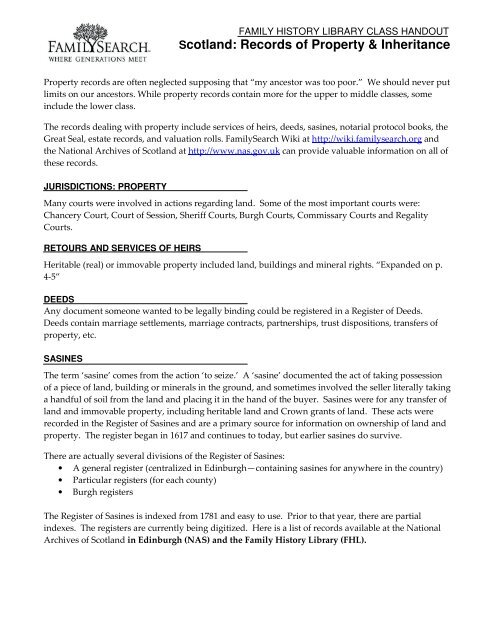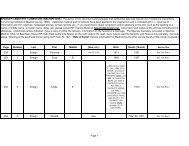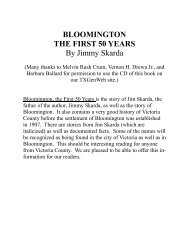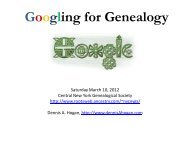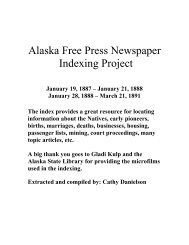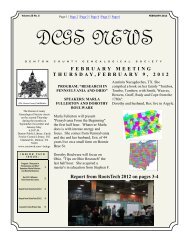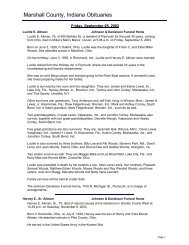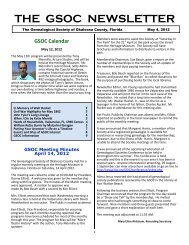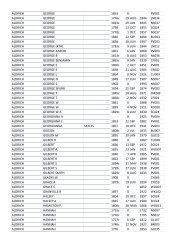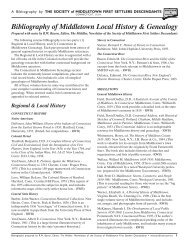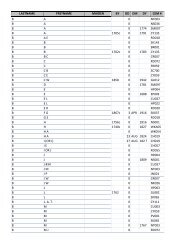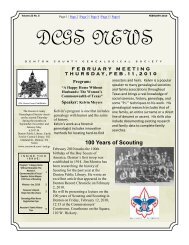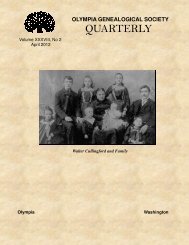Getting to the Roots of Your Family - RootsWeb - Ancestry.com
Getting to the Roots of Your Family - RootsWeb - Ancestry.com
Getting to the Roots of Your Family - RootsWeb - Ancestry.com
You also want an ePaper? Increase the reach of your titles
YUMPU automatically turns print PDFs into web optimized ePapers that Google loves.
FAMILY HISTORY LIBRARY CLASS HANDOUT<br />
Scotland: Records <strong>of</strong> Property & Inheritance<br />
Property records are <strong>of</strong>ten neglected supposing that “my ances<strong>to</strong>r was <strong>to</strong>o poor.” We should never put<br />
limits on our ances<strong>to</strong>rs. While property records contain more for <strong>the</strong> upper <strong>to</strong> middle classes, some<br />
include <strong>the</strong> lower class.<br />
The records dealing with property include services <strong>of</strong> heirs, deeds, sasines, notarial pro<strong>to</strong>col books, <strong>the</strong><br />
Great Seal, estate records, and valuation rolls. <strong>Family</strong>Search Wiki at http://wiki.familysearch.org and<br />
<strong>the</strong> National Archives <strong>of</strong> Scotland at http://www.nas.gov.uk can provide valuable information on all <strong>of</strong><br />
<strong>the</strong>se records.<br />
JURISDICTIONS: PROPERTY<br />
Many courts were involved in actions regarding land. Some <strong>of</strong> <strong>the</strong> most important courts were:<br />
Chancery Court, Court <strong>of</strong> Session, Sheriff Courts, Burgh Courts, Commissary Courts and Regality<br />
Courts.<br />
RETOURS AND SERVICES OF HEIRS<br />
Heritable (real) or immovable property included land, buildings and mineral rights. “Expanded on p.<br />
4-5”<br />
DEEDS<br />
Any document someone wanted <strong>to</strong> be legally binding could be registered in a Register <strong>of</strong> Deeds.<br />
Deeds contain marriage settlements, marriage contracts, partnerships, trust dispositions, transfers <strong>of</strong><br />
property, etc.<br />
SASINES<br />
The term ‘sasine’ <strong>com</strong>es from <strong>the</strong> action ‘<strong>to</strong> seize.’ A ‘sasine’ documented <strong>the</strong> act <strong>of</strong> taking possession<br />
<strong>of</strong> a piece <strong>of</strong> land, building or minerals in <strong>the</strong> ground, and sometimes involved <strong>the</strong> seller literally taking<br />
a handful <strong>of</strong> soil from <strong>the</strong> land and placing it in <strong>the</strong> hand <strong>of</strong> <strong>the</strong> buyer. Sasines were for any transfer <strong>of</strong><br />
land and immovable property, including heritable land and Crown grants <strong>of</strong> land. These acts were<br />
recorded in <strong>the</strong> Register <strong>of</strong> Sasines and are a primary source for information on ownership <strong>of</strong> land and<br />
property. The register began in 1617 and continues <strong>to</strong> <strong>to</strong>day, but earlier sasines do survive.<br />
There are actually several divisions <strong>of</strong> <strong>the</strong> Register <strong>of</strong> Sasines:<br />
• A general register (centralized in Edinburgh—containing sasines for anywhere in <strong>the</strong> country)<br />
• Particular registers (for each county)<br />
• Burgh registers<br />
The Register <strong>of</strong> Sasines is indexed from 1781 and easy <strong>to</strong> use. Prior <strong>to</strong> that year, <strong>the</strong>re are partial<br />
indexes. The registers are currently being digitized. Here is a list <strong>of</strong> records available at <strong>the</strong> National<br />
Archives <strong>of</strong> Scotland in Edinburgh (NAS) and <strong>the</strong> <strong>Family</strong> His<strong>to</strong>ry Library (FHL).


